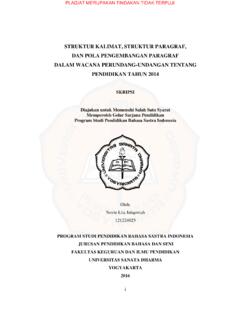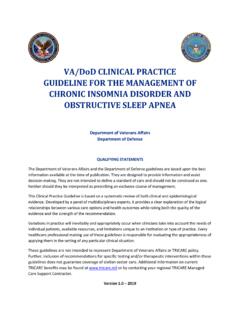Transcription of THE IMPACT OF TRADE OPENNESS ON ECONOMIC GROWTH
1 Erasmus School of Economics THE IMPACT OF TRADE OPENNESS ON ECONOMIC . GROWTH . Evidence in Developing Countries MASTER THESIS. Master: Economics and Business Specialization: International Economics Author: Vasiliki Pigka-Balanika Thesis supervisor: Maarten Bosker 1. Abstract Many economists generally agree that OPENNESS accelerates ECONOMIC development. This study explores the relationship between TRADE OPENNESS and ECONOMIC GROWTH using a sample of 71 developing countries over the period 1990 2005. Incorporating an augmented Solow GROWTH model in a panel data analysis, both fixed and two-way fixed effects specifications indicate that TRADE liberalization has a positive and significant effect on ECONOMIC GROWTH . However, the Sub-Saharan Africa region does appear to be different; high natural barriers to TRADE , export dependence on primary commodities and poor overland infrastructures to distant large markets can explain why increased TRADE OPENNESS does not contribute to ECONOMIC GROWTH .
2 Keywords: TRADE OPENNESS , ECONOMIC GROWTH , neoclassical ECONOMIC model, developing countries, Sub-Saharan African region. 2. Contents I. Introduction 4. II. TRADE OPENNESS : What does it really mean?..5. III. Literature Review 6. IV. Theoretical Part ..10. V. Data and Methodology ..15. VI. Empirical Results 18. VII. Conclusion 22. References 24. Appendix ..28. 3. I. Introduction How TRADE OPENNESS affects ECONOMIC GROWTH is a topic that has amassed a large amount of research. Many economists support that protectionism may induce faster ECONOMIC GROWTH while liberal analysts argue that a higher degree of OPENNESS leads to a better ECONOMIC performance. After all, does TRADE OPENNESS really contribute to ECONOMIC GROWTH ? Few questions have been more strongly debated in the history of ECONOMIC thought.
3 Restricting my attention to 71 developing countries and collecting data from the World Databank, I. investigate the exact IMPACT of TRADE OPENNESS on ECONOMIC GROWTH . Developing countries render a remarkable example as in recent decades; many of them have embarked on programs of external ECONOMIC liberalization. Using the framework of a neoclassical Solow model, whose central predictions concern the IMPACT of investments and population GROWTH on real income, I expand it by adding TRADE OPENNESS as the key variable which proxy for the level of technology, with an altering set of controls as well. Incorporating it in a panel data analysis over the period 1990-2005, I. examine how differently TRADE OPENNESS affects ECONOMIC GROWTH by gradually increasing the number of my explanatory variables.
4 Fixed effects model found that TRADE OPENNESS significantly and positively contribute to ECONOMIC GROWTH after controlling for important causal factors like the initial GDP per capita. The same picture is delivered by a two way fixed effects specification that leads me to more consistent and accurate results, as the country specific heterogeneity is minimized, increasing the explanatory power of my model. However, as I move forward in the course of my survey, I come across evidence showing that the benefits of OPENNESS have shrunk for the poorest developing countries of my sample. Isolating the 30 Sub Saharan African countries of my initial sample, I found that there is no relationship between TRADE OPENNESS and ECONOMIC GROWTH , even though I control for omitted variables bias.
5 This outcome comes in contrast with the main hypothesis that TRADE OPENNESS is a good GROWTH promoting policy and I suppose that for some regions, so structurally different from the rest of the world, such as the SSA region, global comparisons are particularly meaningless. The factors and conditions that can explain why SSA counties are not benefiting from an open TRADE regime is the next focus of my research. Albeit, the rest of the paper is structured as follows: section II analytically refers to how TRADE OPENNESS is defined, section III briefly reviews the theoretical and empirical literature of the OPENNESS - GROWTH nexus and section IV sets out my model specification and variables'. description. As for section V, it bears details of data and methodology and empirical results are presented in section VI.
6 Finally, section VII concludes. 4. II. TRADE OPENNESS : What does it really mean? It is widely accepted that open economies grow faster compared to closed ones. The globalization movement, which accelerated especially in the 1980s, enforced this situation to come into view more clearly. According to Fischer (2003), globalization is defined as the ongoing process of greater ECONOMIC interdependence among countries reflected in the increasing amount of cross-border TRADE in goods and services, the increasing volume of international financial flows and increasing flows of labor . During most of the 20th century, import substitution strategies (ISI)1 played a dominant role in most developing countries'. development strategies. But, while developing countries in Latin America, following ISI.
7 Strategies, achieved lower GROWTH rates, East Asian countries that enacted export promotion policies, experienced a higher ECONOMIC performance. This possibly explains the growing interest of many researchers to investigate the relationship between TRADE liberalization and ECONOMIC performance since the late 1970s. Before analyzing the existing theoretical and empirical literature on the relationship between ECONOMIC GROWTH and TRADE OPENNESS and my own contribution on this specific field of research, I will try to shed light on an important problem facing researchers today; the lack of a clear definition of TRADE liberalization or OPENNESS . The two concepts while closely related are not identical. TRADE liberalization includes policy measures to increase TRADE OPENNESS while increased TRADE OPENNESS is usually considered as an increase in the size of a country's traded sectors in relation to total output.
8 Increased OPENNESS can, but need not, be the result of TRADE liberalization. Recently, the meaning of OPENNESS has become identical to the idea of free TRADE that is a system where all TRADE distortions are eradicated. Pritchett (1996) simply defines OPENNESS as an economy's TRADE intensity. However, according to Kyrre Stenses (2006), it would be more precise to define OPENNESS in relation to barriers to international TRADE imposed by governments. New ECONOMIC geography models (NEG)2 specifically define international TRADE OPENNESS as low international TRADE cost which is an abstraction of transport cost, tariffs, subsidies taxes and non-tariffs barriers. Yanikkaya (2003) mentions that this definition has changed over time from one extreme to another.
9 On the one hand, Krueger (1978) argues that TRADE liberalization can be attained by implementing policies that lower the biases against the exports sector, for instance subsidizing exports or encouraging exports schemes, while on the other hand, Harrison (1996), supports that TRADE OPENNESS could be synonymous with the idea of 1. Strategies which replace foreign imports with domestic production. 2. Study about the location, the distribution and the spatial organization of ECONOMIC activities across the world. 5. neutrality, the indifference between earning a unit of foreign exchange by exporting and saving a unit of foreign exchange through import substitution. It is crucial to understand this definition problem as there are several OPENNESS measures that are differently linked to ECONOMIC GROWTH .
10 However, the purpose of my research is to provide a description of the GROWTH enhancing potential of TRADE OPENNESS and I will continue my analysis in this direction. III. Literature review International TRADE and ECONOMIC GROWTH have been explained through old and new . TRADE and GROWTH theories that explicate why countries TRADE among each other. Neoclassical TRADE theories include comparative advantage and Heckscher-Ohlin Samuelson theories in order to explain the basis for TRADE . In the Ricardian model, as TRADE becomes more open, any country specializes in producing goods in which it has a comparative productivity advantage, which arises due to differences in technologies or natural resources and not in factor endowments, increasing its welfare gains and benefits from TRADE .








